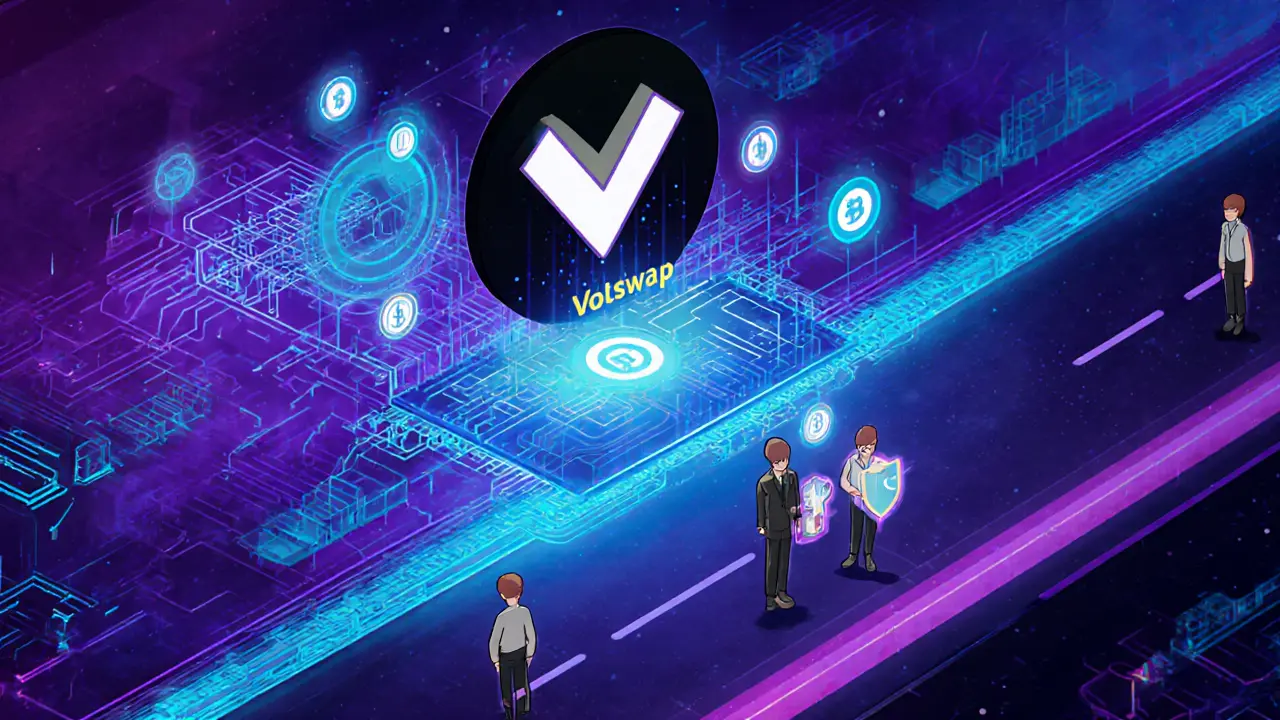
VoltSwap vs. Major DEX Comparison Tool
This tool compares VoltSwap with leading DEXes based on key technical and operational features. Select options below to see how VoltSwap performs against Uniswap and SushiSwap.
Select your preferences and click "Compare DEXes" to see how VoltSwap stacks up against Uniswap and SushiSwap.
Key Takeaways
- VoltSwap runs on the Meter blockchain using a Layer2 design that delivers sub‑second trades and ultra‑low fees.
- The platform claims 100% front‑running resistance and cross‑chain swaps via Meter Passport.
- VOLT, the native governance token, supplies staking rewards but trades at under $0.00025 with daily volume around $6.
- Liquidity is limited to the Meter ecosystem, making large trades pricey compared with Uniswap or SushiSwap.
- Future success hinges on broader Meter adoption and real‑world DeFi integrations.
VoltSwap is a decentralized exchange (DEX) built on the Meter blockchain. Launched as “The Layer 2 swap for the people,” it markets itself as the first front‑running resistant cross‑chain DEX inside the Meter network. The exchange is fully community‑driven, meaning no central team can alter trading rules without a vote from token holders.
Technical Architecture & Core Features
VoltSwap’s tech stack rests on three pillars: a Layer2 roll‑up for speed, a front‑running protection engine, and cross‑chain bridging via Meter Passport. The roll‑up processes transactions off‑chain before finalising them on Meter, shaving seconds off trade latency and slashing fees to fractions of a cent.
The front‑running shield works by randomising transaction order inside each block, a method that neutralises bots that normally front‑run on Ethereum‑based DEXes. For users, this translates to more predictable slippage and fairer price discovery.
Cross‑chain arbitrage is enabled through Meter Passport, which wraps assets from other chains into Meter‑compatible tokens. This lets traders swap, for example, a Binance Smart Chain BEP‑20 token for an ERC‑20 token without leaving the VoltSwap UI.
VoltSwap also introduced an ERC‑721 NFT contract based smart wallet. The wallet is a single‑click solution for yield‑farmers: each NFT represents a unique farming position, making it easy to track rewards and transfer positions without exposing private keys.
Token Economics & Governance
The native token, VOLT, serves both as a governance vehicle and a revenue‑sharing instrument. VOLT has a capped supply of 100million, with roughly 53.87million reported in circulation as of October2025.
Token holders can stake VOLT in a single‑sided pool and receive a share of the exchange’s trading fees. This creates a passive‑income stream that is automatically distributed to stakers, encouraging long‑term token holding.
Governance works through on‑chain proposals. Any holder can submit a change, but only a majority of staked VOLT can enact it. This model keeps the protocol agile while aligning incentives with the community’s financial interests.
Tokenomics allocate 90% of the total supply to farming rewards over a four‑year horizon, meaning a large chunk of VOLT is still locked for future distribution. The remaining 10% covers ecosystem development, marketing, and team vesting.

Market Performance
As of 6October2025, VOLT trades between $0.0002015 and $0.0002413 over a 24‑hour window. The seven‑day range sits at $0.0001886‑$0.0002402. Compared with its all‑time high of $0.2352 in January2022, the token has shed roughly 99.9% of its value.
Daily trading volume is minuscule-about $6 in the last 24hours-but this marks a 285% jump from the previous day, hinting at a slight revival of interest. The most active pair is VOLT/MTRG on the VoltSwap platform itself, underscoring the token’s limited external exchange presence.
Despite the low volume, VOLT outperformed the broader crypto market in the past week, gaining 13.5% while the overall market fell 2.1%. It also beat comparable Theta‑ecosystem tokens, which slipped 21.6% during the same span. These relative gains should be taken with caution, given the tiny market cap behind them.
Platform Accessibility & User Experience
VoltSwap is accessed via a web UI that connects to the Meter blockchain through any Web3‑compatible wallet (MetaMask, Trust Wallet, etc.). Users must hold MTRG tokens to pay transaction fees. The fee structure is simple: a flat 0.01% swap fee plus a minimal network gas cost, often less than $0.00001.
The interface emphasizes community branding, with a dark‑mode chart panel, a quick‑swap widget, and a “Farm” tab for NFT‑based yield positions. While the UI is functional, it lacks the polish and extensive analytics found on larger DEXes such as Uniswap.
No KYC or AML checks are required-users bear full responsibility for complying with local tax regulations. All trades are recorded on‑chain, making them traceable for tax‑reporting purposes.
Pros & Cons
- Pros
- Sub‑second swaps thanks to Layer2 design.
- Front‑running resistance provides fairer pricing.
- Cross‑chain swaps via Meter Passport expand asset coverage.
- Revenue‑sharing staking for VOLT holders.
- Community‑driven governance.
- Cons
- Liquidity is confined to the Meter ecosystem; large orders incur high slippage.
- VOLT price is extremely low and volatile, limiting its appeal as a store of value.
- Meter blockchain adoption trails behind Ethereum, BSC, and Solana.
- Limited third‑party integrations and DApp ecosystem.
- Very low daily trading volume reduces network effects.

VoltSwap vs. Major DEXes
| Feature | VoltSwap | Uniswap (Ethereum) | SushiSwap (Multiple Chains) |
|---|---|---|---|
| Base Network | Meter (Layer2) | Ethereum (L1) | Ethereum, BSC, Polygon, etc. |
| Swap Speed | ~0.5seconds (roll‑up) | ~12seconds (L1) | ~5‑10seconds (varies) |
| Average Fee | 0.01% + negligible gas | 0.30% + gas (~$2‑$5) | 0.20‑0.30% + gas |
| Front‑Running Protection | Built‑in order randomisation | None (MEV bots active) | None (MEV bots active) |
| Cross‑Chain Swaps | Meter Passport (native) | Via third‑party bridges only | Via multi‑chain routers |
| Liquidity (24‑h volume) | ~$6 | $2B+ (Ethereum) | $1B+ (multi‑chain) |
Future Outlook & Risks
VoltSwap’s roadmap promises tighter integration with DeFi lending protocols, expanded NFT‑farm features, and a planned migration to a hybrid L2/L3 scaling model. However, the platform’s growth is tethered to Meter’s overall adoption. If Meter fails to attract developers and users, VoltSwap will likely remain a niche DEX with modest volume.
Regulatory risk is modest because the protocol is permissionless, but users must still meet local tax obligations. Market risk is high given VOLT’s price collapse and thin liquidity.
In short, VoltSwap shines technically but is constrained by network effects. Traders seeking ultra‑low fees and front‑run protection on a small scale may find it attractive, while those needing deep liquidity should stick with larger DEXes.
Frequently Asked Questions
What wallet do I need to trade on VoltSwap?
Any Web3‑compatible wallet that can connect to the Meter blockchain works-MetaMask, Trust Wallet, or the native Meter Wallet app are the most common choices.
How does VoltSwap prevent front‑running?
Transactions are shuffled randomly inside each block before execution, so bots can’t reliably predict the order and profit from it.
Do I need MTRG to pay fees?
Yes. All gas on VoltSwap is paid in MTRG, the native token of the Meter blockchain.
Can I earn passive income with VOLT?
Staking VOLT in the single‑sided pool distributes a portion of the exchange’s swap fees to participants, offering a modest yield.
Is VoltSwap safe to use?
Because it’s a smart‑contract‑based DEX, security depends on the code. The contracts have been audited, but the small user base means fewer real‑world attacks have been observed.


Comments
Promise Usoh
One might contemplate, in the grand tapestry of decentralised finance, that the very notion of a "Layer2" solution transcends mere technicality; it aspires to reshape the philosophical underpinnings of trust. Yet, the execution of VoltSwap appears to wobble like a reed in a storm, bruised by market realities. The front‑running shield is lauded, but does it truly exorcise the spectre of predatory bots, or merely mask it behind randomisation? In my view, the allure of sub‑second swaps is akin to chasing a mirage-ephemeral and alluring, yet perhaps futile when liquidity evaporates. Moreover, the reliance on MTRG for gas may entangle users in a web of dependency that rivals the centralised exchanges they hoped to evade. The tokenomics, with 90% of VOLT earmarked for future rewards, reads like a promise that may never be fulfilled. One is left to wonder if the architecture is built upon solid rock or sand. Ultimately, the project’s success hinges on widespread Meter adoption, a prospect shrouded in uncertainty. In any case, the discourse surrounding VoltSwap invites deeper reflection on what truly constitutes value in DeFi.
Shaian Rawlins
Reading through the detailed review really opened my eyes to how many moving parts there are in a modern DEX. The sub‑second transaction times sound fantastic, especially for folks who are nervous about price slippage. At the same time, the extremely low daily volume, hovering around just a few dollars, makes me pause and think about the real‑world usability. If you’re a casual trader looking for cheap swaps, VoltSwap could be a fun experiment, but if you need deep liquidity for larger positions, you’ll probably hit the wall quickly. The front‑running protection is a neat feature that many larger platforms still struggle with, so that’s a genuine advantage. However, the reliance on the Meter blockchain, which doesn’t have the same network effect as Ethereum or BSC, may limit the ecosystem growth. The staking rewards for VOLT holders are modest but could help bootstrap the community. Overall, I see a niche opportunity here – a place for hobbyists and early adopters who value speed and low fees over massive liquidity.
Tyrone Tubero
Wow, the whole thing sounds like a futuristic sci‑fi plot – Layer2 magic, randomised order, cross‑chain wizardry. But honestly, it feels like they’re selling a shiny gadget without the battery life to back it up. The liquidity numbers are laughably low; you can’t expect a platform with a $6 24‑hour volume to be taken seriously by anyone with a sizable portfolio. And that "front‑running resistance"? Everyone says it, but the reality may be that bots still find a way – after all, no system is truly impenetrable. The token price is basically dust, which makes the whole reward scheme feel like a lottery. Maybe it’s a good playground for developers, but for actual traders it's a precarious gamble.
Taylor Gibbs
It's valuable to keep a balanced perspective. While the tech is impressive, the liquidity constraints are real and affect user experience. New users might appreciate the low fees, but they should also be aware of potential slippage on larger orders. Community governance is a strength, as it aligns incentives, yet it also requires active participation to steer the protocol effectively. As Meter adoption grows, we could see these challenges diminish, turning the platform's early limitations into opportunities.
Rob Watts
Low fees are great.